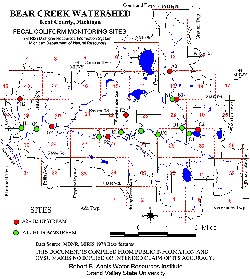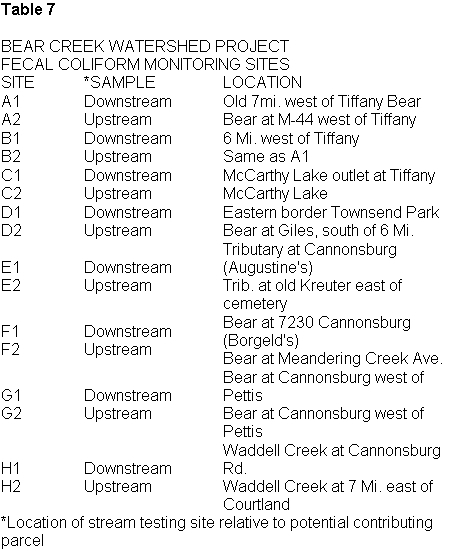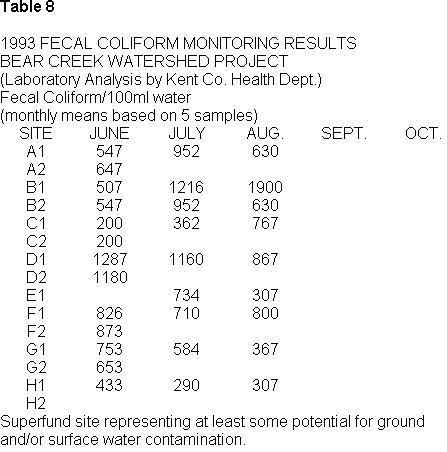Bear Creek Stewardship Plan - Contributing and/or Related Factors Affecting Water Quality



Water quality assessments are carried out by Project staff and community volunteers utilizing alternative measures, including presence and type of macro-invertebrate species, Ph and dissolved oxygen levels, and stream velocity. Groups of students from Cannonsburg School and Lakes School, as well as members of the Grand Rapids Public Schools' Stream Teams and three Adopt-a-Stream teams which have adopted Bear Creek and its tributaries are providing these assessments on a regular basis to WMEAC and the Water Resources Institute. As a rule, Project staff participate in these assessments and also have organized additional monitoring efforts involving local colleges. Two Calvin College students are currently assessing the impact of sedimentation on Stout Creek and tracking organic pollution from road runoff in Bear Creek.
A variety of factors are associated with or contribute to the water quality concerns in the Bear Creek Watershed, including those related to coliform levels and other measures of water health. These include soil erosion from water and wind on unprotected agricultural fields, construction sites, and other vulnerable surfaces; stormwater runoff from impervious groundcovers such as concrete and asphalt; removal or loss of native ground cover and failure to replace the cover with appropriate vegetation; and inattention to appropriate maintenance of waste disposal systems for human and livestock waste.
Other factors include problematic road and drain construction and/or maintenance on public and private properties; destruction of or damage to watershed wetland areas; historical and current practices of stream diversion and/or damming (with associated obstructions of the natural patterns of fish migration and watercourse flow); and, the presence of an unremediated former.
Table 6
Fecal Coliform Monitoring Results 1989-1993 Kent County Health Dept. Fecal Coliform/100ml water (monthly means based on 5 samples)
Site
Year
April
May
June
July
August
September
October
Bear Creek at Giles 89 90 91 259 355 596 745 956 1243 564 Bear Creek at Townsend Park 89 33 101 282 3050 1737 419 294 90 111 441 405 681 393 683 720 91 214 200 422 1989 836 990 426 92 93 90 91 254 197 290 356 548 842 449 92 93 265 537 580 1208 Bear at Chauncy 89 90 91 220 223 387 534 459 608 524 92 68 223 387 534 459 608 524 93 160 506 1016 1060 Little Bostwick Lake 92 10 10 10
Figure 12.
click here for larger image
Still another potential factor may be the contribution of toxins and heavy metals from airborne and waterborne sources. These toxins include those which are emitted in Kent and adjacent counties as well as those which are carried into the watershed area by the prevailing westerly wind pattern across the North American continent from Wisconsin across Lake Michigan and into West Michigan. Although a precise estimate of the amount of these toxins and metals found specifically in the waters of the Bear Creek Watershed is not presently known, there is a likelihood that the watershed is at risk for contamination from these sources.
Even without the contribution of toxins and heavy metals from other states, Kent County has the greatest number of toxic release facilities and emissions of any county in the entire Grand River Watershed, contributing 11 million pounds of releases and transfers. Ottawa County ranks second, with 10 million pounds, and Muskegon (due west of the Bear Creek Watershed, but only a small part of the Grand River Watershed), ranks third with 9 million pounds.
It should be noted, that airborne emissions do not respect watershed boundaries, so that contamination of subwatersheds of the Grand River such as Bear Creek from emissions should be explored in greater detail.
Finally - as a contributing problem evident in the Watershed in 1992-1993 - the citizens who live, work, or own property in the area do not have an adequate knowledge base from which to address the documented number and variety of complex water resource issues, despite a generally high level of interest in and enthusiasm for water and land stewardship practices. The need for a comprehensive, ongoing, and focused educational effort around water quality concerns is evident, particularly for streamside residents, farmers (including "hobby farmers"), fourth and fifth grade students in public and private schools, and residential developers.
Furthermore, the implementation of BMPs and the educational effort require the active involvement of informed public officials at every governmental level, and of private and public organizations and agencies. Steps toward the development a solid foundation of official support have been taken in the planning year of the Project, but need further attention in the implementation stage(s) to follow if the overall project is to achieve its most successful outcome.
